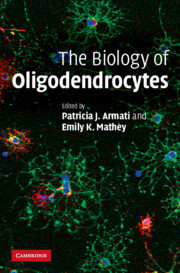Book contents
- Frontmatter
- Contents
- Preface
- Contributors
- 1 CNS oligarchs; the rise of the oligodendrocyte in a neuron-centric culture
- 2 Comparative biology of Schwann cells and oligodendrocytes
- 3 Control of oligodendrocyte development and myelination in the vertebrate CNS
- 4 Molecular organization of the oligodendrocyte and myelin
- 5 The genetics of oligodendrocytes
- 6 Immunobiology of the oligodendrocyte
- 7 Oligodendrocytes and disease: repair, remyelination and stem cells
- 8 Glial progenitor cells and the dynamics of the oligodendrocyte and its myelin in the aged and injured CNS
- 9 Oligodendroglial pathology in multiple sclerosis
- 10 Glutamate receptors, transporters and periventricular leukomalacia
- References
- Index
- Plate section
3 - Control of oligodendrocyte development and myelination in the vertebrate CNS
Published online by Cambridge University Press: 05 August 2012
- Frontmatter
- Contents
- Preface
- Contributors
- 1 CNS oligarchs; the rise of the oligodendrocyte in a neuron-centric culture
- 2 Comparative biology of Schwann cells and oligodendrocytes
- 3 Control of oligodendrocyte development and myelination in the vertebrate CNS
- 4 Molecular organization of the oligodendrocyte and myelin
- 5 The genetics of oligodendrocytes
- 6 Immunobiology of the oligodendrocyte
- 7 Oligodendrocytes and disease: repair, remyelination and stem cells
- 8 Glial progenitor cells and the dynamics of the oligodendrocyte and its myelin in the aged and injured CNS
- 9 Oligodendroglial pathology in multiple sclerosis
- 10 Glutamate receptors, transporters and periventricular leukomalacia
- References
- Index
- Plate section
Summary
INTRODUCTION
The oligodendrocyte lineage is among the best studied and most well understood of all the lineages in the vertebrate central nervous system (CNS). Oligodendrocytes are the cells responsible for the formation of CNS myelin. Structurally compact as distinct from non-compact myelin appears as concentric wraps of modified plasma membrane that ensheathe individual lengths, i.e. internodes, of neuronal processes or axons, that connect neurons with their targets. This compact internodal myelin is discontinuous as each of the up to 50 oligodendrocyte processes forms only one internode. The myelination by the oligodendrocyte processes results in accelerated conduction of signals along the axons and lowering of the threshold for propagating such signals. In the adult CNS, myelination is critical for the normal functioning of the CNS such that diseases and injury that result in the loss of myelin lead to functional deficits. The ability to isolate and grow cells in culture that will generate oligodendrocytes has allowed researchers to understand some of the fundamental steps that lead from a neural stem cell to a myelinating oligodendrocyte in the adult CNS. The identification of oligodendrocyte-lineage-specific cell surface molecules, growth factor receptors and transcription factors has facilitated the labeling and manipulation of the lineage both in vivo and in culture. These studies have revealed extensive plasticity in the development of oligodendrocytes and provided critical insights into the behavior of oligodendrocytes and their oligodendrocyte precursor cells during development in a variety of different regions of the CNS as well as under a number of pathological conditions.
- Type
- Chapter
- Information
- The Biology of Oligodendrocytes , pp. 49 - 63Publisher: Cambridge University PressPrint publication year: 2010
- 2
- Cited by



